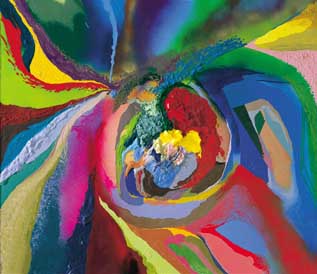The Candor of Cali: Chris Johanson at The Portland Art Museum
Amy Bernstein
Originally published by PORT February 15, 2007

The latest APEX spotlight to hit the Portland Art Museum this month is Portland-based artist Chris Johanson. In the past couple of years, Johanson (who is currently represented by the Jack Hanley Gallery) has received national and international attention as part of a group of artists hailing from San Francisco’s Mission District. Occasionally titled “The Mission School” this group of artists (including Barry McGee, his late wife Margaret Kilgallen, and Alicia McCarthy, among many others) revels in the intersection of public, private and the D.I.Y. philosophy of a generation suffocated by consumer culture. Inspired by the for(u)m of graffiti as the art of the people and its intent to reach an audience perhaps wider and more diverse than simply those that visit the gallery that particular month, these artists have revived sincerity and observation as something worth making art about. Not hackneyed or kitschy in the slightest, they have developed sophisticated, unique languages that draw attention to the contemporary condition. Influenced by street culture but not created by it, these artists honestly confront their own visions on their own terms and then present them to us. Unfiltered and poetic, these works are a refreshing break from the heady, often self- absorbed agenda of the east, and thus, despite much due attention, these artists remain just a bit outside of the ? current of contemporary rhetoric.
In the Portland Art Museum’s designated corner for the APEX series artists, Chris Johanson’s installations and drawings immediately stand apart formally and conceptually from the rest of the floor’s Northwest artists. Johanson’s work feels light when compared to most of the work on the floor, the making quick and unconcerned with immortality. Drawings have been ripped from sketchbooks with perforated edges in tact, and the wood used to build frames and walls is found or recycled. Johanson’s work is imbued with a childlike freedom, yet is also somewhat bipolar. He bounces between figuration and abstraction randomly, yet always makes it seem appropos. We find him unpretentious, yet demanding of our time and attention.
My first encounter with Chris Johanson and his wife and art partner, Jo Jackson, was through an article in the Los Angeles based, grass roots publication, ANP Quarterly. Theirs was a visual language of spirituality created for a lost people, and this is what most of Johanson’s work seems to speak of. He hails the doubts and spirits of contemporary living, making the thoughts and energies of humans visible. Fragile, small, often self-deprecating, these figures endear themselves in the extremity of their candor. Their bodies are an amalgamation of swirling colors, and their thought bubbles never seem big enough to contain their undulating thoughts. Sometimes, the figures interact with one another. Yet often, they are only next to one another, alone with the weight of their own thoughts. The text becomes formal poetry, a candid confession of the state of the world. There are discussions of love and meds, suicide, and fear. The drawing is inventive and expressive despite its simplicity, every formal element intentional. Johanson’s installations are merely the environmental dimension of all of this. The two pieces: Light Show #4 and The Way of the World as Humans Know It installed and created with Johanson’s peer, Kal Spelletich, in an irregular womb room also built of found wood is the culmination of the drawings. Inside, colored light bulbs blink in random order behind a sundial-like mountain form while a mandala-like painting spins upon detecting the movement of viewers inside the womb. A small bench waits patiently between the two entities, beckoning contemplation. The introduction of the element of time as a cycle hints of mortality and rebirth. The painted figures on the spinning mandala hint of ancient spiritualities as the figures on the circular canvas fly and dive, contemplate, and pray and die as the painting rotates. No text is present inside this room. This room is the hum of Johanson’s commentary and celebration of life.

Occasionally, in an effort to hold staunchly fast to the ideals of purity, Johanson’s drawings become too obvious and almost slightly insulting in their simplicity, demanding “earth people” to “stop being assholes” in the first of a series of framed drawings. The proceeding drawings, arranged in a three-dimensional frame of found wood, depict a person in a car driving first to the left and telling a friend by phone that he will arrive even later than expected. In the next drawing the person drives to the right and by night. In the last drawing, someone drives while smiling and thinking about a piece of displayed sculpture in an ornate room. Behind these images, a Non-Time Specific Molecular Contemporary Landscape hangs. Indeed, we understand. We drive too much. We have lost ourselves in the soulless artifice of remorseless consumptive practice. We are assholes. This arrangement is the weakest area of Johanson’s work at the museum and not at all exemplary of the language he has developed. It is the failure of the execution of an ideal whose push has become too automatic, perhaps the danger of too stringent ideologies in general. While the PAM does not represent the rich extent of this prolific artist’s oeuvre, it gives a small and intriguing taste. Chris Johanson’s provoking presence foils preconceptions of the institution and decorates the APEX series with the freedom and boundless possibility of the state of contemporary art.
